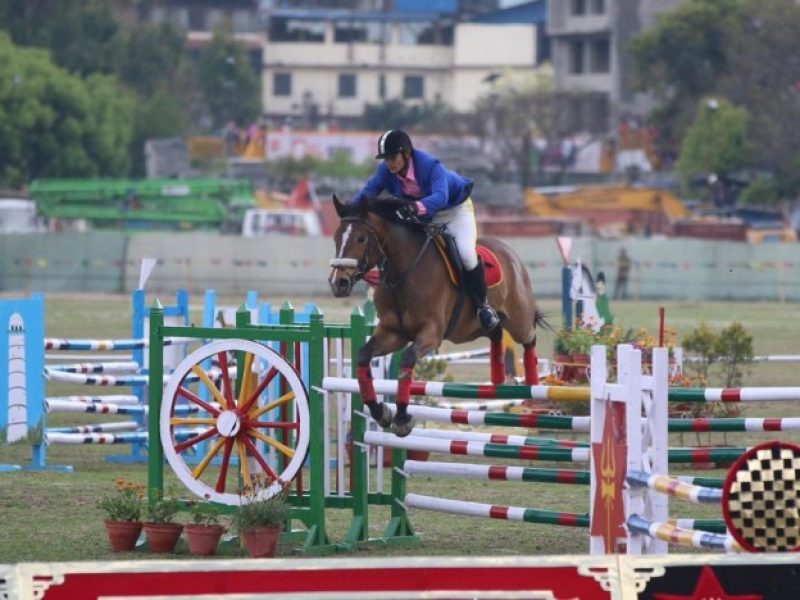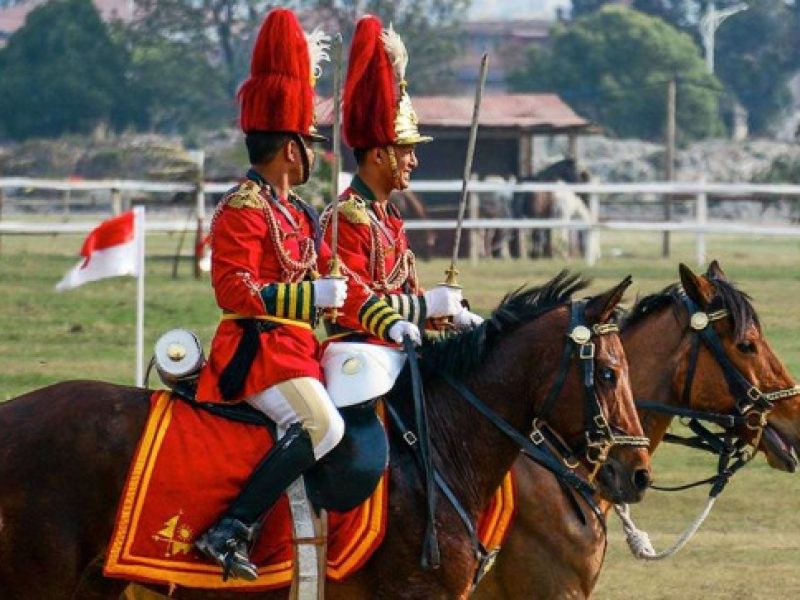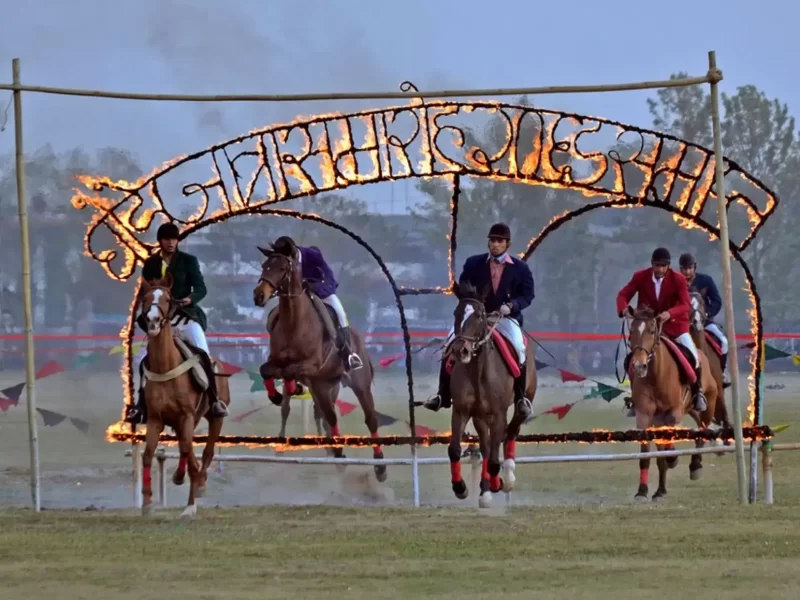Ghode Jatra, or “Horse Parade,” is an annual festival in Kathmandu, Nepal which is celebrated with great ceremony and magnificence. The event, typically held in late March or early April, heralds the arrival of spring and marks the Nepalese New Year, known as Navavarsha.
The event takes place at Tundikhel, a vast open ground nestled amidst the urban sprawl of Kathmandu. The procession begins with the magnificent horses, adorned in vibrant attire and ceremonial decorations, exuding an aura of majesty and grace.
The riders, dressed in traditional attire, guide their mounts through the streets, demonstrating their equestrian prowess. The Nepalese Army showcases their discipline and skill with precision drills and choreographed routines.
The festivities continue with various cultural performances, including traditional dances, music, and theatrical presentations. Horse Parade holds a deeper significance in Nepalese culture, as it celebrates the enduring bond between humans and horses, symbolizing power, strength, and nobility.
Ghode Jatra Origins To Cultural Celebration
This festival is an ancient festival in Nepal, and has its roots in mythology and historical events. Legend suggests that people began the festival as a protective ritual to ward off a malevolent demon named Tundi, who they believed resided in the city’s main square.
Over time, Ghode Jatra evolved from a protective ritual into a grand celebration, marking the arrival of spring and paying homage to the horse, a revered symbol of power, strength, and nobility in Nepalese culture.

Over time, this festival became a symbol of unity and communal harmony, bringing together people from all walks of life to celebrate their shared heritage and traditions. The festival is marked by a myriad of cultural traditions, each imbued with its own significance and symbolism.
Generally, the central aspect of the festival is the procession of horses, adorned in colorful regalia and ceremonial decorations, evokes a sense of awe and reverence.
Today, Ghode Jatra continues to be celebrated with great pomp and splendor in Kathmandu and other parts of Nepal. It serves as a reminder of the importance of preserving and celebrating tradition, honoring the equine spirit and the enduring legacy of Nepal’s cultural heritage.
Ghode Jatra Nepalese Festival Celebrating Horses And Culture
It takes place in late March or early April, coinciding with the Nepalese festival of Navavarsha (Nepali New Year). The main event takes place at Tundikhel, a vast open ground in the heart of Kathmandu, where a colorful spectacle unfolds.

As the day dawns, anticipation fills the air, and the streets surrounding Tundikhel come alive with excitement. Spectators gather along the parade route, eagerly awaiting the procession of horses, adorned in vibrant attire and ceremonial decorations.
Riders, dressed in traditional attire, demonstrate their equestrian skills, performing intricate maneuvers and acrobatics to the delight of onlookers. One of the highlights of this jatra is the ceremonial display by the Nepalese Army, showcasing their cavalry’s prowess with precision drills and choreographed routines.
The rhythmic drum beats and sight of majestic horses galloping in unison create a mesmerizing spectacle, reflecting the unity and strength of the nation.
Cultural Significance Of This Festival
Ghode Jatra is a significant cultural event in Nepal, honoring the equine spirit, tradition, and history. During the festival, people adorn horses in vibrant attire, revering them for their power, strength, and loyalty, and highlighting their cultural significance.
- The festival originates from ancient times, blending mythology and history.
- It’s linked to Tundi, a demon, believed to show the strength of rituals against adversity.
- Ghode Jatra promotes unity among communities, breaking barriers.
- It brings people together regardless of caste, creed, or ethnicity.
- The festival helps in safeguarding Nepal’s cultural legacy by passing down traditions.
- In today’s fast-changing world, Horse Parade is vital for preserving Nepal’s heritage.
- Various efforts like education and awareness aim to ensure this festival and other cultural traditions continue.
Preserving Ghode Jatra While Upholding Tradition
A traditional Nepalese festival is a symbol of the country’s cultural heritage despite the challenges of urbanization and globalization. Despite its historical resilience, the festival has evolved to incorporate modern elements.

People are working hard to keep Ghode Jatra alive. They’re doing this by teaching about it, getting communities involved, and coming up with new ideas. The preserving methods for this festival can be:
- Schools, groups that care about culture, and the government are all helping out. They’re making sure everyone knows why Ghode Jatra is special and what it means.
- It’s really important that communities stay connected to Ghode Jatra. This keeps the festival true to its roots and still important to people today.
- New ideas can make Ghode Jatra even better. Things like being eco-friendly and using technology can make the festival more fun and last longer.
- In Nepal, as things change, it’s super important to keep traditions like Ghode Jatra going. They’re part of what makes Nepal special and shouldn’t be forgotten.
Conclusion
In conclusion, Ghode Jatra is a traditional Nepalese festival that celebrates the bond between humans and horses. The event, which takes place in Kathmandu, serves as a reminder of Nepal’s rich heritage and the enduring spirit of its people. Despite modernization and change, Ghode Jatra remains a beacon of resilience, preserving age-old customs while embracing innovation and adaptation. Therefore, organizations like Trek Me Nepal play a pivotal role in promoting cultural preservation and sustainable tourism, ensuring that festivals like Ghode Jatra continue to thrive and enrich the lives of locals and visitors.
Frequently Asked Questions (FAQs)
1.What is Ghode Jatra?
In Nepal, especially in Kathmandu, people celebrate the annual Ghode Jatra festival to honor the equine spirit and commemorate the victory over the malevolent demon Tundi, with a grand celebration featuring a procession of beautifully adorned horses, cultural performances, and traditional rituals..
2.When is Ghode Jatra celebrated?
It typically falls in late March or early April, coinciding with the Nepalese New Year, known as Navavarsha. The exact date varies each year based on the lunar calendar.
3.What is the significance of Ghode Jatra?
It holds profound cultural significance in Nepalese society. It pays homage to the equine spirit, symbolizing power, strength, and nobility. The festival also commemorates the victory over the demon Tundi, representing the triumph of good over evil.
4.How is Ghode Jatra celebrated?
Ghode Jatra is celebrated with great pomp and splendor in Kathmandu, where a procession of horses, accompanied by traditional music and cultural performances, parades through the streets. The Nepalese Army also participates in ceremonial displays, showcasing their cavalry’s prowess.
5.Are there any specific rituals associated with Ghode Jatra?
Yes, Horse Parade is accompanied by various traditional rituals and customs. One such ritual involves riding horses around the perimeter of Tundikhel, the main parade ground in Kathmandu, to ward off evil spirits and protect the city.
6.Can tourists participate in Ghode Jatra festivities?
While Ghode Jatra is primarily a local celebration, tourists are welcome to observe and participate in the festivities. It offers visitors a unique opportunity to experience Nepalese culture and traditions firsthand.
7.Are there any safety precautions to consider during Ghode Jatra?
As with any large-scale event, it’s essential for participants and spectators to exercise caution and follow safety guidelines. Crowded streets and loud noises from the procession can be overwhelming, so it’s advisable to stay aware of your surroundings and follow instructions from local authorities.
8.How can I learn more about Ghode Jatra and other cultural events in Nepal?
Organizations like Trek Me Nepal offer cultural tours and experiences that provide insights into Nepal’s rich heritage, including festivals like Horse Parade. Additionally, you can explore online resources, visit cultural museums, or engage with local communities to learn more about Nepalese culture and traditions.
Introducing Trek Me Nepal: Embark on Unforgettable Journeys
At Trek Me Nepal, every step you take should be an adventure, every breath you inhale should be filled with the essence of nature, and every heartbeat should resonate with the rhythm of the mountains. We are a passionate team of explorers committed to crafting unforgettable trekking experiences in the breathtaking landscapes of Nepal.

Comment (0)